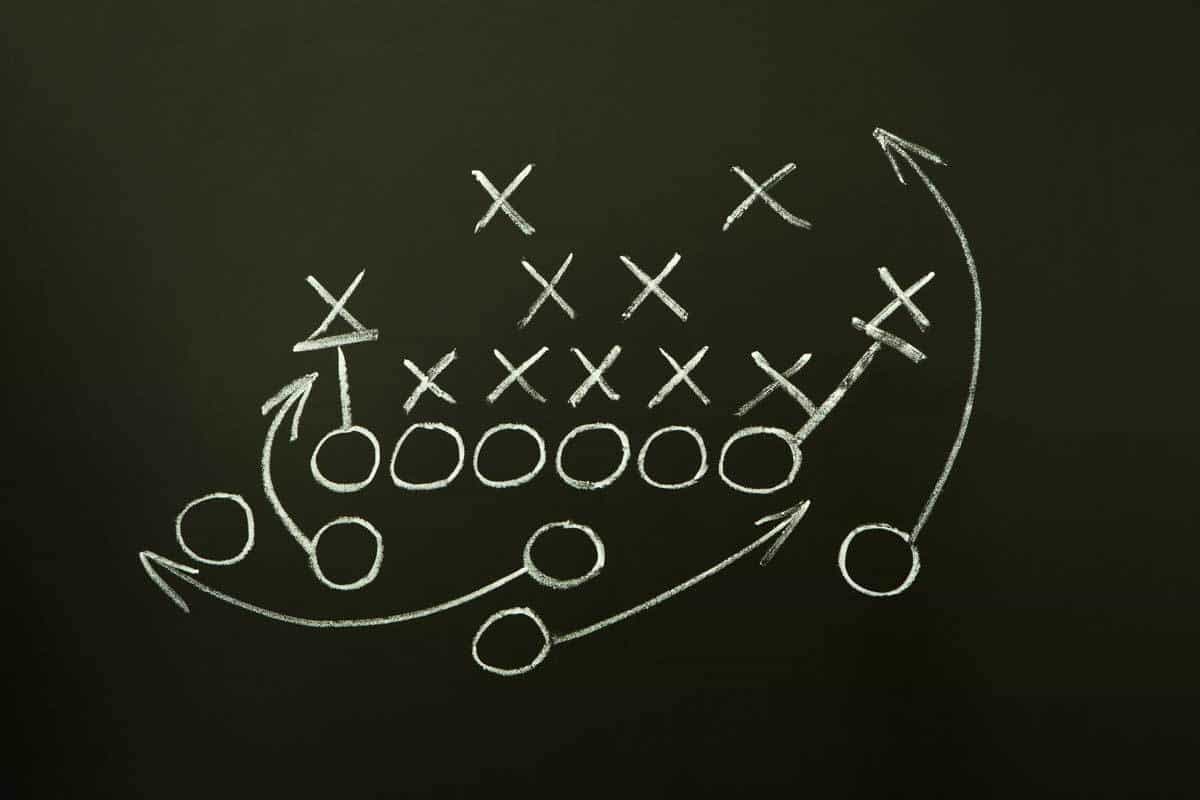Welcome to another new Gator Country regular feature — Tom Furland’s “Greaseboard” sessions where he fields questions and uses his deep technical knowledge of all things football to share his answers, often with useful diagrams to give you an at-a-glance picture of what he means. This series accompanies Tom’s detailed film room (breakdown) weekly columns. Enjoy!
The “buck” — Are there examples of where we show 3-4 and go 4-3 and vice versa? Or is this just a pass rushing linebacker, ala a regular 3-4?
A: Really what we’re looking at when you say going between 3-4 and 4-3 is a difference between over and under fronts. Our base front is a traditional 4-3 over front, which means the 3-technique is going to be aligned on the strong side of the formation, like below:
We’ll use this when we want to put our strength on the strong side of the defense against the 3-man blocking surface and encourage the offense to run weakside where we can pursue and close with the Buck and Will. It’s especially useful when the weakside is the boundary side of the field.
Sometimes we’ll go to more of a hybrid of a 4-3 under and a 3-4 eagle with some 2-gap principles at the N and T positions, where the Buck either stands up or puts a hand down, depending on what we want to show:

This is a little more balanced as compared to our over front. You’ll see a variation of this a lot against balanced sets when the TE and S are off the field (replaced by a receiver and nickel) and the end will be shaded outside.
Most times rather than going to a 4-3 under we’ll go to more of a hybrid 3-4 under where the buck stands up. You’ll rarely see us go to a true 2-gap 3-4 Okie with 2-gap across the board on the defensive line. 3-4 under looks like this:
This is similar to the hybrid front above except it provides a little more protection for the Will backer as he’s not lining up over an uncovered player, thus he has more freedom to flow to the ball.
So really, the Buck is just a flexible position that can play the role of both a 3-4 outside linebacker on the weak side of the front in coverage/pass rush or a 4-3 defensive end in run fits. It’s tailor made for freak athletes with length, a quick downhill step, and good lateral mobility as with the right player it really will shut down the weakside of the defense and allow Will to roam and play fast.
Can you explain why this is a better offense for JD?
I know its a spread system and we are all excited about Roper’s offense, but what are the particulars for the QB that make this so much better for a run/pass type situation (if I’m saying that right). And why is it easier to learn (which is what I have read on this board)?
Much has been said about how this offense is a much better fit for Driskel’s skill set. Can you explain why that is so and if you believe some of his past difficulties will be rectified in this offense?
A: This offense is better for JB for several reasons:
- Calls, progressions, and formations are simplified.
- Spread formations simplify the disguises a defense can give you at this level, making pre-snap reads more reliable.
- He’s not being asked to hold the ball and go 3-4 deep in a progression
- He’s being utilized as a running threat more consistently, which creates an extra gap for the defense to account for on a higher percentage of plays
- Singleback formations plus a credible tight end created either a threat to both seams (2×2) or an overload of the secondary to one side (3×1) creates difficulty in going to a post safety look and should be able to dictate more quarters and cover 2, opening up the ground game.
- Packaged plays that make the defense wrong every time, which we will get into in a few weeks
We all know the new offense will help the passing game, how does it effect [sic] the running game? Will the new offense help the deficiencies at OL?
A: I think we will see significantly more inside and outside zone runs with arc blocks from the B-position as opposed to Pease’s 2 back power/counter scheme. The nice thing about zone runs is the rules are simple and stunts cause fewer problems. That should help the OL but I think having players injured and playing out of position was the biggest deficiency on our OL last year.
How does Roper’s passing game differ from Pease’s?
A: More passing out of 2×2 and 3×1 sets to stress the seams of the defense, primarily 5 and 6 man slide protection, more moving pocket/rollout type plays, better use of the quick passing game, more packaged plays with run/pass options, tempo, and an emphasis on making every play positive and taking what is there.
Oh, and he’s far better at teaching it to his players from everything I’ve heard.
Was Pease incompetent or did he just fail in execution?
A: From a schematic standpoint, what he was calling wasn’t unsound. That said, I think his offense was confusing for our players and not enough for our opposition yet it tried too hard at times to physically impose our will on opposition that matched up with us well physically. I also think at times he tried too hard to ask players to win matchups they weren’t capable of winning last year. That said, I think the reason he was fired was more about his personality and his ability (or lack thereof) to teach and recruit.
Roper’s ideal sizes for the different WR and TE positions (if there are any) for our offensive scheme. Same thing with the DB’s & Safeties for Muschamp.
A: At TE we want someone 6’4” or better, ideally at least 220 coming in and playing at 240-plus. As the TE position is more of a flex position in this offense that doesn’t really line up as much with a hand in the dirt, it’s more important that the tight end have good ability to get downfield through traffic without being redirected, with good hands and an ability to go up and catch and take a hit while being too fast for most LBs and too big for most SSs or CBs.
WR I think we still want someone 6-feet plus on the outside that can get off a press and threaten the cover 2 void or beat a corner over the top and go up and get the ball. With our slot receivers, we need someone fast who can avoid a re-direct and take the top off the coverage, but I still don’t think we’re looking for speed at any expense like Urban. We want someone with enough size to be able to consistently give defenses problems if they use some sort of post safety rat in the hole look trying to slow down seam routes.
Help me understand why our Oline failed so miserably last year…at least from a scheme perspective…and more to the point….why this year will be different with many of the the same kids?
A: I recognize injuries were in play, so perhaps it was simply personnel and inexperience…but far too often our Oline had guys running free from every direction.
Personnel was the biggest reason. We had a kid who was not a tackle playing tackle, a guy at guard who couldn’t read a stunt after 4 years and was playing with half his usual upper body strength, another guy slowed by knee injuries, and problems getting our depth on campus. By the end of the year Harrison was the only guy playing where he was supposed to and healthy.
Schemes both were a relatively minor problem as our pass pro and running schemes were relatively standard fare. I think once guys started going down we probably could have done a little more to help out the guys we had left such as moving toward zone runs and away from power/counter and gone to more full slide protections rather than split 3-man zone/2-man BOB, but I think any schematic change would really only have led to a marginal improvement as at a couple of the positions on the line we were just overmatched physically.
Fact is, Tyler Moore was too slow for most ends, Humphries was hurt the first game of the year and it affected his mobility, Halapio had 1 pec and was supposed to be challenged by Moore (who I think will be a quality guard), Brown got here late and was playing terribly at T until very late in the year, and later Garcia was forced to tackle forcing a 3rd string role player into service at LG. There’s not much any coach could have done for the OL given the circumstances.
If you have questions for me to pick from, be sure to post them on our premium BullGator Den forum. See you there.



